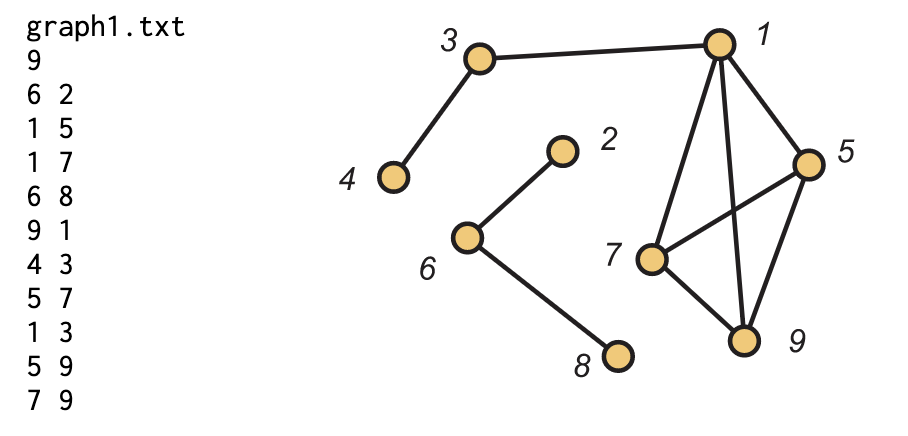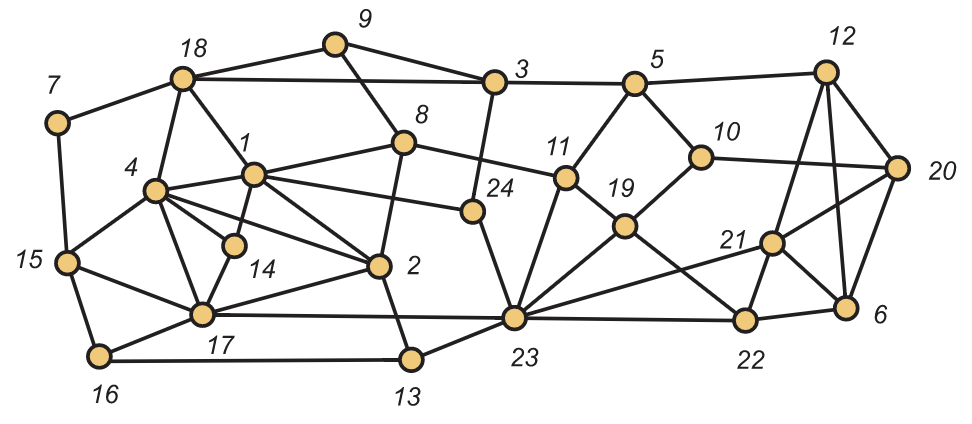1.3: Combinatorics and Graph Theory
- Page ID
- 97847
A graph \(G\) consists of a vertex set \(V\) and a collection \(E\) of 2-element subsets of \(V\). Elements of \(E\) are called edges. In our course, we will (almost always) use the convention that \(V=\{1,2,3,...,n\}\) for some positive integer \(n\). With this convention, graphs can be described precisely with a text file:
- The first line of the file contains a single integer \(n\), the number of vertices in the graph.
- Each of the remaining lines of the file contains a pair of distinct integers and specifies an edge of the graph.
We illustrate this convention in Figure 1.2 with a text file and the diagram for the graph \(G\) it defines.

Much of the notation and terminology for graphs is quite natural. See if you can make sense out of the following statements which apply to the graph \(G\) defined above:
- \(G\) has 9 vertices and 10 edges.
- \(\{2,6\}\) is an edge.
- Vertices 5 and 9 are adjacent.
- \(\{5,4\}\) is not an edge.
- Vertices 3 and 7 are not adjacent.
- \(P = (4,3,1,7,9,5)\) is a path of length 5 from vertex 4 to vertex 5.
- \(C = (5,9,7,1) \) is cycle of length 4.
- \(G\) is disconnected and has two components. One of the components has vertex set \(\{2,6,8\}\).
- \(\{1,5,7\}\) is a triangle.
- \(\{1,7,5,9\}\) is a clique of size 4.
- \(\{4,2,8,5\}\) is an independent set of size 4.
Equipped only with this little bit of background material, we are already able to pose a number of interesting and challenging problems.
Consider the graph \(G\) shown in Figure 1.4.

- What is the largest \(k\) for which \(G\) has a path of length \(k\)?
- What is the largest \(k\) for which \(G\) has a cycle of length \(k\)?
- What is the largest \(k\) for which \(G\) has a clique of size \(k\)?
- What is the largest \(k\) for which \(G\) has an independent set of size \(k\)?
- What is the shortest path from vertex 7 to vertex 6?
Suppose we gave the class a text data file for a graph on 1500 vertices and asked whether the graph contains a cycle of length at least 500. Raoul says yes and Carla says no. How do we decide who is right?
Suppose instead we asked whether the graph has a clique of size 500. Helene says that she doesn't think so, but isn't certain. Is it reasonable that her classmates insist that she make up her mind, one way or the other? Is determining whether this graph has a clique of size 500 harder, easier or more or less the same as determining whether it has a cycle of size 500.
We will frequently study problems in which graphs arise in a very natural manner. Here's an example.
In Figure 1.6, we show the location of some radio stations in the plane, together with a scale indicating a distance of 200 miles. Radio stations that are closer than 200 miles apart must broadcast on different frequencies to avoid interference.

We've shown that 6 different frequencies are enough. Can you do better?
Can you find 4 stations each of which is within 200 miles of the other 3? Can you find 8 stations each of is more than 200 miles away from the other 7? Is there a natural way to define a graph associated with this problem?
How big must an applied combinatorics class be so that there are either (a) six students with each pair having taken at least one other class together, or (b) six students with each pair together in a class for the first time. Is this really a hard problem or can we figure it out in just a few minutes, scribbling on a napkin?


